Evaluation of the Thermal Environment Based on the Urban Neighborhood Heat/Cool Island Effect
Abstract
:1. Introduction
2. Materials and Methods
2.1. Study Area and Data
2.2. Method
2.2.1. Urban Thermal Landscapes Analysis
2.2.2. Sky View Factor
2.2.3. Spatial Neighboring Analysis
2.2.4. Buffer Analysis
2.2.5. Boosted Regression Trees
3. Results
3.1. Distribution of the UNHI and UNCI
3.2. Relationships between 3D Buildings and the Neighborhood Thermal Environment
3.2.1. Relationships between Building Classification and the UNHI/UNCI
3.2.2. Relationships between the SVF and the UNHI/UNCI
3.3. Relationships between Green Patches and the Neighborhood Thermal Environment
3.3.1. Relationships between Green Patch Grades and the UNHI/UNCI
3.3.2. Cooling Effect of Green Patch Grades
3.4. Relationships between the UFZs and the Neighborhood Thermal Environment
3.4.1. Relationships between the UFZs and the Urban Thermal Landscapes
3.4.2. Relative Influence of UFZs on the UNHI/UNCI
4. Discussion
4.1. Improvement in the Neighborhood Thermal Environment
4.2. Influence of 3D Buildings on the UNHI and UNCI Distribution
4.3. Factors Influencing the UNHI and UNCI
4.4. Limitations and Future Avenues
5. Conclusions
Author Contributions
Funding
Data Availability Statement
Conflicts of Interest
References
- Rizwan, A.M.; Dennis, Y.C.L.; Liu, C. A review on the generation, determination and mitigation of Urban Heat Island. J. Environ. Sci. 2008, 20, 120–128. [Google Scholar] [CrossRef] [PubMed]
- Sailor, D.J. Simulated urban climate response to modifications in surface albedo and vegetative cover. J. Appl. Meteorol. 1995, 34, 1694–1704. [Google Scholar] [CrossRef]
- Manley, G. On the frequency of snowfall in metropolitan England. Q. J. R. Meteorol. Soc. 1958, 84, 70–72. [Google Scholar] [CrossRef]
- Huang, C.; Tang, Y.; Wu, Y.; Tao, Y.; Xu, M.; Xu, N.; Li, M.; Liu, X.; Xi, H.; Ou, W. Assessing Long-Term Thermal Environment Change with Landsat Time-Series Data in a Rapidly Urbanizing City in China. Land 2024, 13, 177. [Google Scholar] [CrossRef]
- Sun, F.; Liu, M.; Wang, Y.; Wang, H.; Che, Y. The effects of 3D architectural patterns on the urban surface temperature at a neighborhood scale: Relative contributions and marginal effects. J. Clean. Prod. 2020, 258, 120706. [Google Scholar] [CrossRef]
- Chapman, S.; Watson, J.E.M.; Salazar, A.; Thatcher, M.; McAlpine, C.A. The impact of urbanization and climate change on urban temperatures: A systematic review. Landsc. Ecol. 2017, 32, 1921–1935. [Google Scholar] [CrossRef]
- Gago, E.J.; Roldan, J.; Pacheco-Torres, R.; Ordóñez, J. The city and urban heat islands: A review of strategies to mitigate adverse effects. Renew. Sustain. Energy Rev. 2013, 25, 749–758. [Google Scholar] [CrossRef]
- Jamei, E.; Ossen, D.R.; Rajagopalan, P. Investigating the effect of urban configurations on the variation of air temperature. Int. J. Sustain. Built Environ. 2017, 6, 389–399. [Google Scholar] [CrossRef]
- Chen, L.; Ng, E.; An, X.; Ren, C.; Lee, M.; Wang, U.; He, Z. Sky view factor analysis of street canyons and its implications for daytime intra-urban air temperature differentials in high-rise, high-density urban areas of Hong Kong: A GIS-based simulation approach. Int. J. Climatol. 2012, 32, 121–136. [Google Scholar] [CrossRef]
- Guo, G.; Wu, Z.; Xiao, R.; Chen, Y.; Liu, X.; Zhang, X. Impacts of urban biophysical composition on land surface temperature in urban heat island clusters. Landsc. Urban Plan. 2015, 135, 1–10. [Google Scholar] [CrossRef]
- Kondo, H.; Kikegawa, Y. Temperature variation in the urban canopy with anthropogenic energy use. Pure Appl. Geophys. 2003, 160, 317–324. [Google Scholar] [CrossRef]
- Shashua-Bar, L.; Hoffman, M.E. Vegetation as a climatic component in the design of an urban street: An empirical model for predicting the cooling effect of urban green areas with trees. Energy Build. 2000, 31, 221–235. [Google Scholar] [CrossRef]
- Saito, I.; Ishihara, O.; Katayama, T. Study of the effect of green areas on the thermal environment in an urban area. Energy Build. 1990, 15, 493–498. [Google Scholar] [CrossRef]
- Honjo, T.; Takakura, T. Simulation of thermal effects of urban green areas on their surrounding areas. Energy Build. 1990, 15, 443–446. [Google Scholar] [CrossRef]
- Yan, H.; Wu, F.; Dong, L. Influence of a large urban park on the local urban thermal environment. Sci. Total Environ. 2018, 622–623, 882–891. [Google Scholar] [CrossRef] [PubMed]
- Emmanuel, R.; Loconsole, A. Green infrastructure as an adaptation approach to tackling urban overheating in the Glasgow Clyde Valley Region, UK. Landsc. Urban Plan. 2015, 138, 71–86. [Google Scholar] [CrossRef]
- Masson, V.; Lion, Y.; Peter, A.; Pigeon, G.; Buyck, J.; Brun, E. “Grand Paris”: Regional landscape change to adapt city to climate warming. Clim. Chang. 2013, 117, 769–782. [Google Scholar] [CrossRef]
- Qiu, K.; Du, H.; Zhang, L.; Zhang, W.; Li, H. Study on the Carbon Saving Value of Urban Greenspace Patches in the Main Cities of Yangtze River Delta Based on the Cooling Effect. J. Ecol. Rural Environ. 2022, 38, 1282–1289. [Google Scholar]
- Chang, C.-R.; Li, M.-H.; Chang, S.-D. A preliminary study on the local cool-island intensity of Taipei city parks. Landsc. Urban Plan. 2007, 80, 386–395. [Google Scholar] [CrossRef]
- Qiu, K.; Zhang, H.; Gao, J.; Pei, W.; Zhang, B.; Wang, M.; Wang, Q. Variation of cool island effect for urban forest patches across an urban-rural gradient in Shanghai. Chin. J. Ecol. 2021, 40, 1409–1418. [Google Scholar]
- Kirschner, V.k.; Moravec, D.; Macků, K.; Kozhoridze, G.; Komárek, J. Comparing the Effects of Green and Blue Bodies and Urban Morphology on Land Surface Temperatures Close to Rivers and Large Lakes. Land 2024, 13, 162. [Google Scholar] [CrossRef]
- Liu, Y.; Zhu, R.; Qian, J.; Dang, C.; Yue, H. Land Surface Temperature Downscaling Based on Multiple Factors. Remote Sens. Inf. 2020, 35, 6–18. [Google Scholar]
- Sun, R.; Chen, L. How can urban water bodies be designed for climate adaptation? Landsc. Urban Plan. 2012, 105, 27–33. [Google Scholar] [CrossRef]
- Xu, J.; Wei, Q.; Huang, X.; Zhu, X.; Li, G. Evaluation of human thermal comfort near urban waterbody during summer. Build. Environ. 2010, 45, 1072–1080. [Google Scholar] [CrossRef]
- Zhang, Q.; Wen, Y.; Wu, Z.; Chen, Y. Seasonal Variations of the Cooling Effect of Water Landscape in High-density Urban Built-up Area: A Case Study of the Center Urban District of Guangzhou. Ecol. Environ. Sci. 2018, 27, 1323–1334. [Google Scholar]
- Zeng, S.; Shi, Z.; Zhao, M.; Liu, F.; Wang, G.; Lin, Y.; Li, Q.; Xiang, Z.; Chen, X.; Ogbodo, U.S. The variation of buffer performance of water bodies on urban heat island along riverbank distance. Acta Ecol. Sin. 2020, 40, 5190–5202. [Google Scholar]
- Deilami, K.; Kamruzzaman, M.; Liu, Y. Urban heat island effect: A systematic review of spatio-temporal factors, data, methods, and mitigation measures. Int. J. Appl. Earth Obs. Geoinf. 2018, 67, 30–42. [Google Scholar] [CrossRef]
- Li, S.; Shen, Z.; Ke, Y.; Li, J.; Xu, Z.; Wang, H.; Jiao, S.; Li, L.; Li, L. Spatial-Temporal Variation and Driving Forces of Land Use Types in the Daqing River Basin from 1974 to 2019. Res. Soil Water Conserv. 2021, 28, 195–203, 210. [Google Scholar]
- Xian, G.; Shi, H.; Zhou, Q.; Auch, R.; Gallo, K.; Wu, Z.; Kolian, M. Monitoring and characterizing multi-decadal variations of urban thermal condition using time-series thermal remote sensing and dynamic land cover data. Remote Sens. Environ. 2022, 269, 112803. [Google Scholar] [CrossRef]
- Wang, H.; Zhang, Y.; Tsou, J.Y.; Li, Y. Surface Urban Heat Island Analysis of Shanghai (China) Based on the Change of Land Use and Land Cover. Sustainability 2017, 9, 1538. [Google Scholar] [CrossRef]
- Li, W.; Bai, Y.; Chen, Q.; He, K.; Ji, X.; Han, C. Discrepant impacts of land use and land cover on urban heat islands: A case study of Shanghai, China. Ecol. Indic. 2014, 47, 171–178. [Google Scholar] [CrossRef]
- Yang, C.; He, X.; Yan, F.; Yu, L.; Bu, K.; Yang, J.; Chang, L.; Zhang, S. Mapping the Influence of Land Use/Land Cover Changes on the Urban Heat Island Effect—A Case Study of Changchun, China. Sustainability 2017, 9, 312. [Google Scholar] [CrossRef]
- Murakawa, S.; Sekine, T.; Narita, K.-i.; Nishina, D. Study of the effects of a river on the thermal environment in an urban area. Energy Build. 1991, 16, 993–1001. [Google Scholar] [CrossRef]
- Feranec, J.; Kopecká, M.; Szatmári, D.; Holec, J.; Stastny, P.; Pazúr, R.; Bobál’ová, H. A review of studies involving the effect of land cover and land use on the urban heat island phenomenon, assessed by means of the MUKLIMO model. Geografie 2019, 124, 83–101. [Google Scholar] [CrossRef]
- Li, X.-X.; Koh, T.-Y.; Panda, J.; Norford, L.K. Impact of urbanization patterns on the local climate of a tropical city, Singapore: An ensemble study. J. Geophys. Res. Atmos. 2016, 121, 4386–4403. [Google Scholar] [CrossRef]
- Oleson, K. Contrasts between Urban and Rural Climate in CCSM4 CMIP5 Climate Change Scenarios. J. Clim. 2012, 25, 1390–1412. [Google Scholar] [CrossRef]
- Adachi, S.A.; Kimura, F.; Kusaka, H.; Duda, M.G.; Yamagata, Y.; Seya, H.; Nakamichi, K.; Aoyagi, T. Moderation of Summertime Heat Island Phenomena via Modification of the Urban Form in the Tokyo Metropolitan Area. J. Appl. Meteorol. Climatol. 2014, 53, 1886–1900. [Google Scholar] [CrossRef]
- Huang, G.; Cadenasso, M.L. People, landscape, and urban heat island: Dynamics among neighborhood social conditions, land cover and surface temperatures. Landsc. Ecol. 2016, 31, 2507–2515. [Google Scholar] [CrossRef]
- Sanders, R.A. Urban vegetation impacts on the hydrology of Dayton, Ohio. Urban Ecol. 1986, 9, 361–376. [Google Scholar] [CrossRef]
- Li, C.; Liu, M.; Hu, Y.; Shi, T.; Qu, X.; Walter, M.T. Effects of urbanization on direct runoff characteristics in urban functional zones. Sci. Total Environ. 2018, 643, 301–311. [Google Scholar] [CrossRef]
- Yao, L.; Chen, L.; Wei, W.; Sun, R. Potential reduction in urban runoff by green spaces in Beijing: A scenario analysis. Urban For. Urban Green. 2015, 14, 300–308. [Google Scholar] [CrossRef]
- Song, T.; Duan, Z.; Liu, J.; Shi, J.; Yan, F.; Sheng, S.; Huang, J.; Wu, W. Comparison of four algorithms to retrieve land surface temperature using Landsat 8 satellite. J. Remote Sens. 2015, 19, 451–464. [Google Scholar]
- Xu, H.; Tang, F. Analysis of new characteristics of the first Landsat 8 image and their ecoenvironmental significance. Acta Ecol. Sin. 2013, 33, 3249–3257. [Google Scholar]
- Liu, M.; Ma, J.; Zhou, R.; Li, C.; Li, D.; Hu, Y. High-resolution mapping of mainland China’s urban floor area. Landsc. Urban Plan. 2021, 214, 104187. [Google Scholar] [CrossRef]
- Xu, H.Q.; Chen, B.Q. Remote sensing of the urban heat island and its changes in Xiamen City of SE China. J. Environ. Sci. 2004, 16, 276–281. [Google Scholar]
- Yu, Y.-F.; Pan, J.; Xing, L.-X.; Jiang, L.-J.; Liu, S.; Yuan, Y.; Yu, H.-L. Identification of high temperature targets in remote sensing imagery based on factor analysis. J. Appl. Remote Sens. 2014, 8, 083622. [Google Scholar] [CrossRef]
- Jiang, J.; Qiao, Z. Impact Analysis of Land Surface Temperature(LST) Land Use Change on Beijing. Remote Sens. Inf. 2012, 27, 105–111. [Google Scholar]
- Zhou, W.; Tian, Y. Effects of urban three-dimensional morphology on thermal environment:a review. Acta Ecol. Sin. 2020, 40, 416–427. [Google Scholar]
- Wang, Y.; Akbari, H. Effect of Sky View Factor on Outdoor Temperature and Comfort in Montreal. Environ. Eng. Sci. 2014, 31, 272–287. [Google Scholar] [CrossRef]
- Lin, T.-P.; Tsai, K.-T.; Hwang, R.-L.; Matzarakis, A. Quantification of the effect of thermal indices and sky view factor on park attendance. Landsc. Urban Plan. 2012, 107, 137–146. [Google Scholar] [CrossRef]
- Zaksek, K.; Ostir, K.; Kokalj, Z. Sky-View Factor as a Relief Visualization Technique. Remote Sens. 2011, 3, 398–415. [Google Scholar] [CrossRef]
- Loarie, S.R.; Duffy, P.B.; Hamilton, H.; Asner, G.P.; Field, C.B.; Ackerly, D.D. The velocity of climate change. Nature 2009, 462, 1052–1055. [Google Scholar] [CrossRef] [PubMed]
- Hamann, A.; Roberts, D.R.; Barber, Q.E.; Carroll, C.; Nielsen, S.E. Velocity of climate change algorithms for guiding conservation and management. Glob. Chang. Biol. 2015, 21, 997–1004. [Google Scholar] [CrossRef] [PubMed]
- Brito-Morales, I.; Molinos, J.G.; Schoeman, D.S.; Burrows, M.T.; Poloczanska, E.S.; Brown, C.J.; Ferrier, S.; Harwood, T.D.; Klein, C.J.; McDonald-Madden, E. Climate velocity can inform conservation in a warming world. Trends Ecol. Evol. 2018, 33, 441–457. [Google Scholar] [CrossRef] [PubMed]
- Shen, Z. Variability of Urban Thermal Environment for Functional Regions of Construction Land in Xiamen City. Sci. Geogr. Sin. 2022, 42, 1627–1637. [Google Scholar]
- Monteiro, M.V.; Doick, K.J.; Handley, P.; Peace, A. The impact of greenspace size on the extent of local nocturnal air temperature cooling in London. Urban For. Urban Green. 2016, 16, 160–169. [Google Scholar] [CrossRef]
- Doick, K.J.; Peace, A.; Hutchings, T.R. The role of one large greenspace in mitigating London’s nocturnal urban heat island. Sci. Total Environ. 2014, 493, 662–671. [Google Scholar] [CrossRef] [PubMed]
- Aertsen, W.; Kint, V.; Van Orshoven, J.; Muys, B. Evaluation of modelling techniques for forest site productivity prediction in contrasting ecoregions using stochastic multicriteria acceptability analysis (SMAA). Environ. Model. Softw. 2011, 26, 929–937. [Google Scholar] [CrossRef]
- Elith, J.; Leathwick, J.R.; Hastie, T. A working guide to boosted regression trees. J. Anim. Ecol. 2008, 77, 802–813. [Google Scholar] [CrossRef]
- Gao, Y.; Zhao, J. Assessing the Contribution and Impact of the Block Morphological Factors on the Surface Thermal Environment Using Multi-Source Data. J. Hum. Settl. West China 2023, 38, 30–37. [Google Scholar]
- Wu, Z.; Yao, L.; Zhuang, M.; Ren, Y. Detecting factors controlling spatial patterns in urban land surface temperatures: A case study of Beijing. Sust. Cities Soc. 2020, 63, 102454. [Google Scholar] [CrossRef]
- Gao, J.; Gong, J.; Li, J. Effects of source and sink landscape pattern on land surface temperature:An urban heat island study in Wuhan City. Prog. Geogr. 2019, 38, 1770–1782. [Google Scholar] [CrossRef]
- Wu, J.; Li, C.; Zhang, X.; Zhao, Y.; Liang, J.; Wang, Z. Seasonal variations and main influencing factors of the water cooling islands effect in Shenzhen. Ecol. Indic. 2020, 117, 106699. [Google Scholar] [CrossRef]
- Zhao, Z.; Sharifi, A.; Dong, X.; Shen, L.; He, B.-J. Spatial Variability and Temporal Heterogeneity of Surface Urban Heat Island Patterns and the Suitability of Local Climate Zones for Land Surface Temperature Characterization. Remote Sens. 2021, 13, 4338. [Google Scholar] [CrossRef]
- Li, L.-G.; Xu, S.-L.; Wang, H.-B.; Zhao, Z.-Q.; Cai, F.; Wu, J.-W.; Chen, P.-S.; Zhang, Y.-S. Urban heat island effect based on urban heat island source and sink indices in Shenyang, Northeast China. Ying Yong Sheng Tai Xue Bao = J. Appl. Ecol. 2013, 24, 3446–3452. [Google Scholar]
- Wang, W.; Zhang, Y. Quantitative analysis of controllable factors affecting thermal environment in city residential area. J. Zhejiang Univ. Eng. Sci. 2010, 44, 2348–2353, 2382. [Google Scholar]
- Guo, J.; Han, G.; Xie, Y.; Cai, Z.; Zhao, Y. Exploring the relationships between urban spatial form factors and land surface temperature in mountainous area: A case study in Chongqing city, China. Sust. Cities Soc. 2020, 61, 102286. [Google Scholar] [CrossRef]
- Morakinyo, T.E.; Lam, Y.F. Simulation study on the impact of tree-configuration, planting pattern and wind condition on street-canyon’s micro-climate and thermal comfort. Build. Environ. 2016, 103, 262–275. [Google Scholar] [CrossRef]
- Armson, D.; Rahman, M.A.; Ennos, A.R. A Comparison of the Shading Effectiveness of Five Different Street Tree Species in Manchester, UK. Arboric. Urban For. (AUF) 2013, 39, 157–164. [Google Scholar] [CrossRef]
- Zhou, Y.; Zhao, H.; Mao, S.; Zhang, G.; Jin, Y.; Luo, Y.; Huo, W.; Pan, Z.; An, P.; Lun, F. Exploring surface urban heat island (SUHI) intensity and its implications based on urban 3D neighborhood metrics: An investigation of 57 Chinese cities. Sci. Total Environ. 2022, 847, 157662. [Google Scholar] [CrossRef]
- Malevich, S.B.; Klink, K. Relationships between snow and the wintertime Minneapolis urban heat island. J. Appl. Meteorol. Climatol. 2011, 50, 1884–1894. [Google Scholar] [CrossRef]
- Taha, H. Urban climates and heat islands: Albedo, evapotranspiration, and anthropogenic heat. Energy Build. 1997, 25, 99–103. [Google Scholar] [CrossRef]
- Sun, R.; Lu, Y.; Chen, L.; Yang, L.; Chen, A. Assessing the stability of annual temperatures for different urban functional zones. Build. Environ. 2013, 65, 90–98. [Google Scholar] [CrossRef]
- Alavipanah, S.; Schreyer, J.; Haase, D.; Lakes, T.; Qureshi, S. The effect of multi-dimensional indicators on urban thermal conditions. J. Clean. Prod. 2018, 177, 115–123. [Google Scholar] [CrossRef]
- Park, M.; Hagishima, A.; Tanimoto, J.; Narita, K.-i. Effect of urban vegetation on outdoor thermal environment: Field measurement at a scale model site. Build. Environ. 2012, 56, 38–46. [Google Scholar] [CrossRef]
- Susca, T.; Gaffin, S.R.; Dell’Osso, G. Positive effects of vegetation: Urban heat island and green roofs. Environ. Pollut. 2011, 159, 2119–2126. [Google Scholar] [CrossRef] [PubMed]
- Cai, Z.; Guldmann, J.-M.; Tang, Y.; Han, G. Does city-water layout matter? Comparing the cooling effects of water bodies across 34 Chinese megacities. J. Environ. Manag. 2022, 324, 116263. [Google Scholar] [CrossRef] [PubMed]
- Jiang, L.; Liu, S.; Liu, C.; Feng, Y. How do urban spatial patterns influence the river cooling effect? A case study of the Huangpu Riverfront in Shanghai, China. Sust. Cities Soc. 2021, 69, 102835. [Google Scholar] [CrossRef]
- Masoudi, M.; Tan, P.Y. Multi-year comparison of the effects of spatial pattern of urban green spaces on urban land surface temperature. Landsc. Urban Plan. 2019, 184, 44–58. [Google Scholar] [CrossRef]
- Srivanit, M.; Iamtrakul, P. Spatial patterns of greenspace cool islands and their relationship to cooling effectiveness in the tropical city of Chiang Mai, Thailand. Environ. Monit. Assess. 2019, 191, 580. [Google Scholar] [CrossRef]
- Cheng, Y.-T.; Wu, C.-G. Planning approach of urban blue-green space based on local climate optimization: A review. Ying Yong Sheng Tai Xue Bao = J. Appl. Ecol. 2020, 31, 3935–3945. [Google Scholar] [CrossRef]
- Cao, X.; Onishi, A.; Chen, J.; Imura, H. Quantifying the cool island intensity of urban parks using ASTER and IKONOS data. Landsc. Urban Plan. 2010, 96, 224–231. [Google Scholar] [CrossRef]
- Peng, J.; Jia, J.; Liu, Y.; Li, H.; Wu, J. Seasonal contrast of the dominant factors for spatial distribution of land surface temperature in urban areas. Remote Sens. Environ. 2018, 215, 255–267. [Google Scholar] [CrossRef]
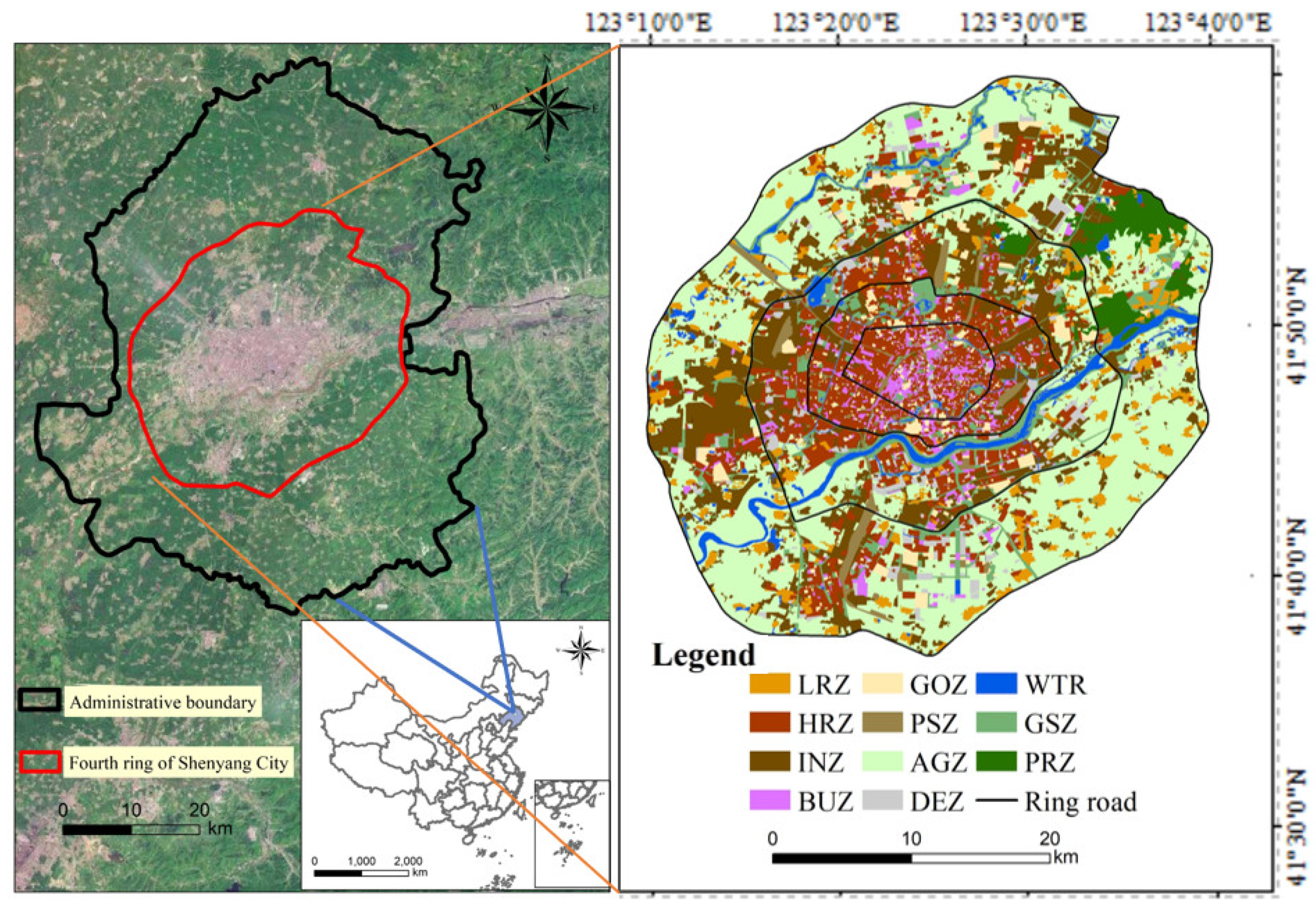
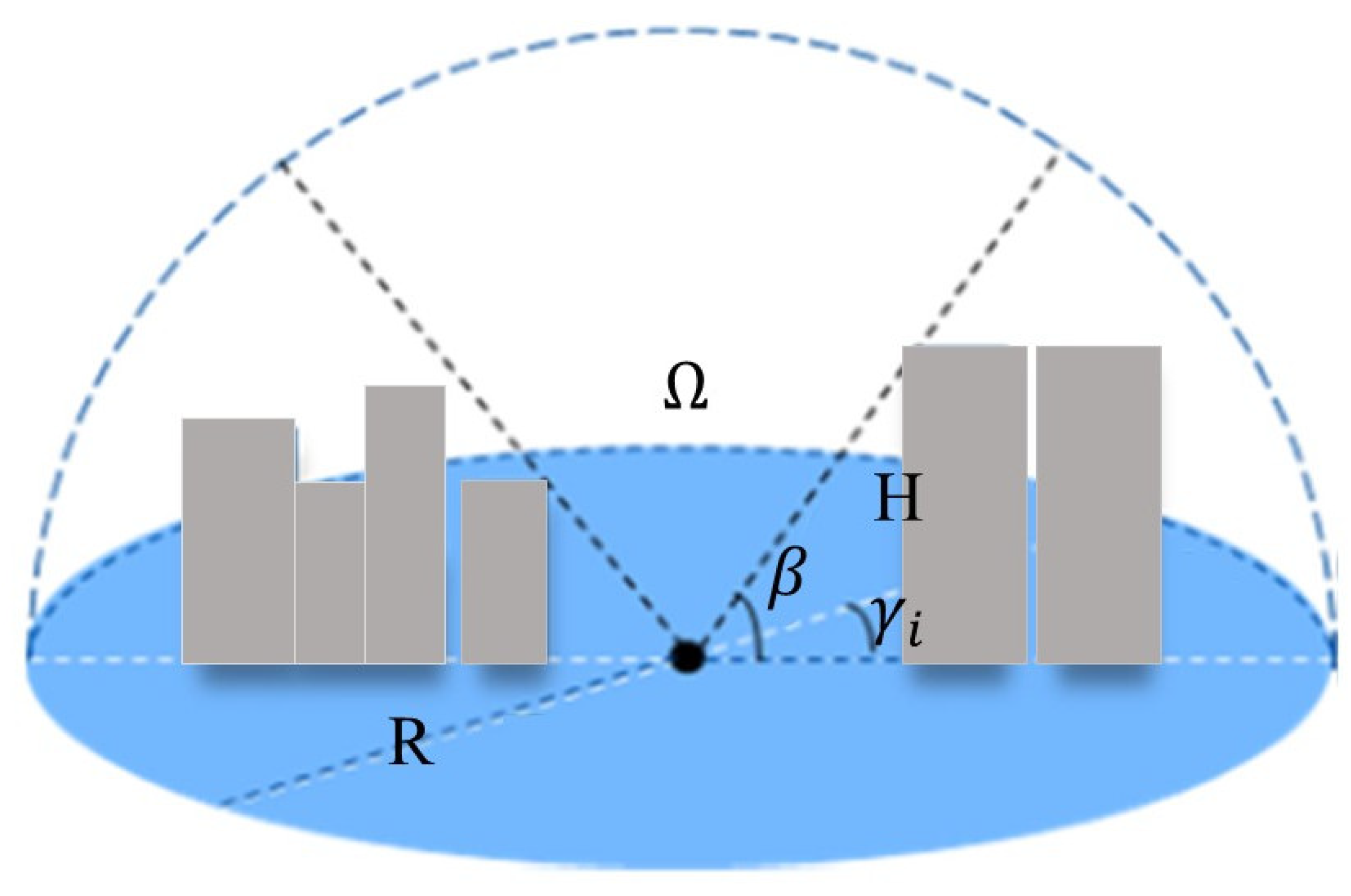
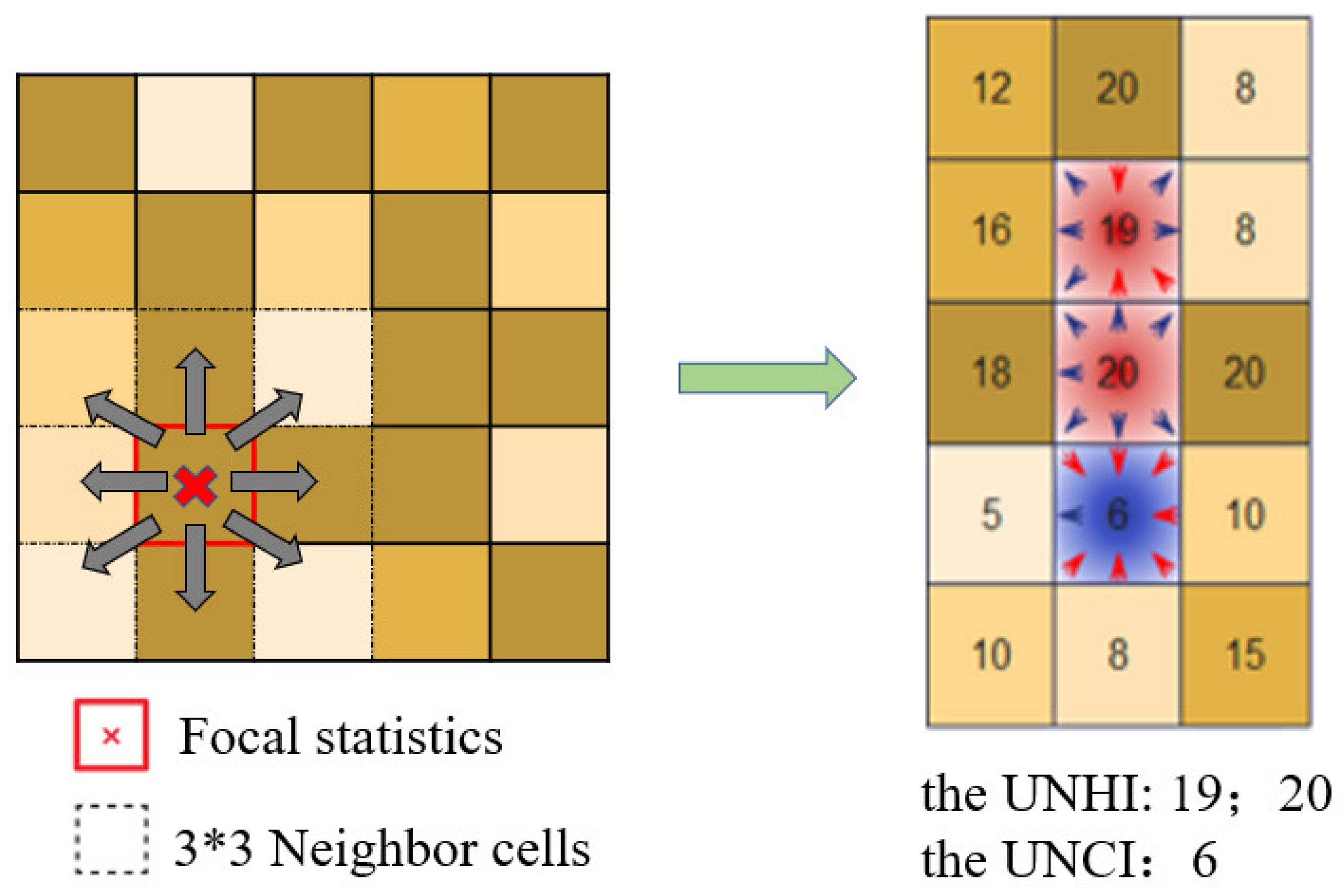
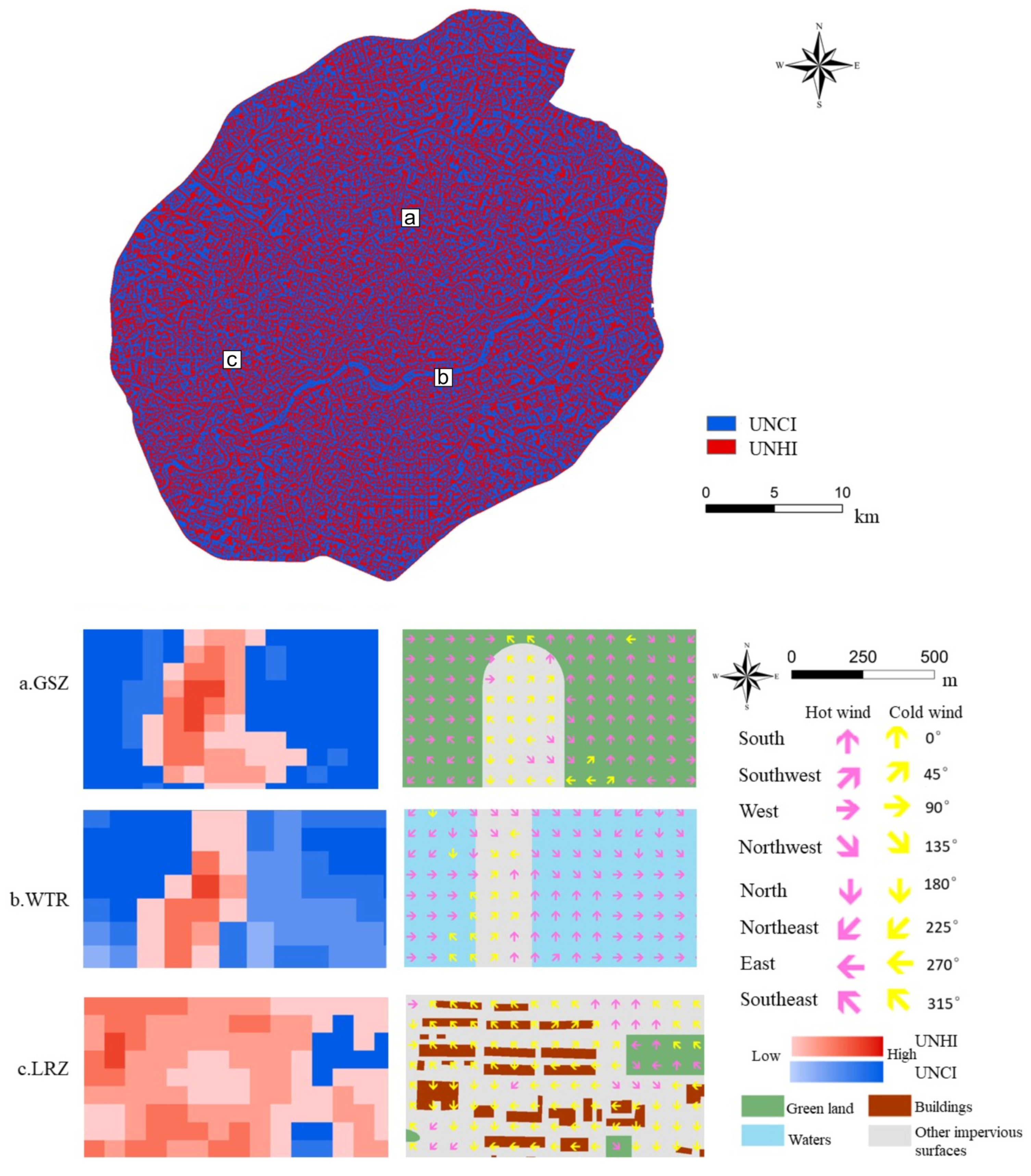





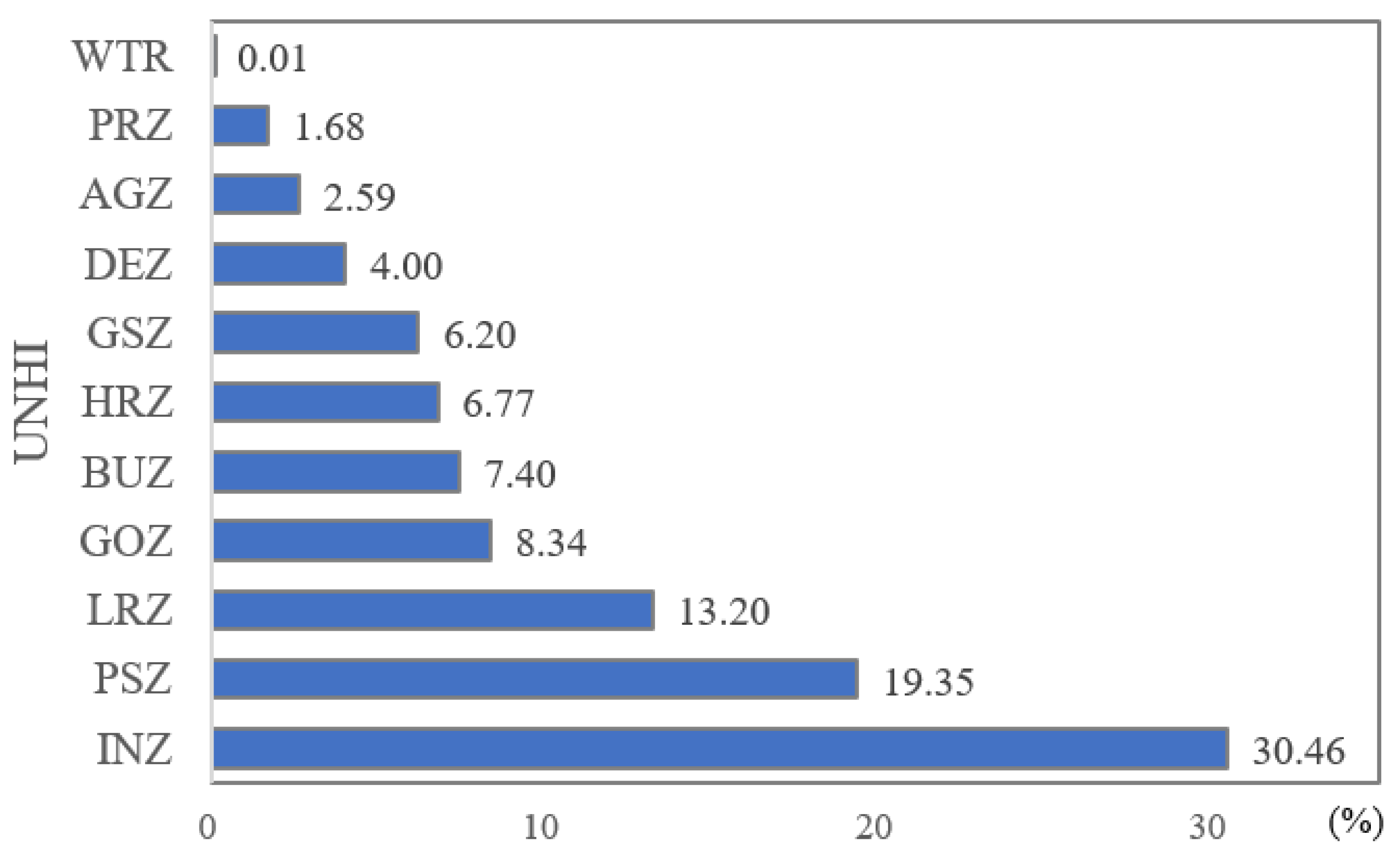
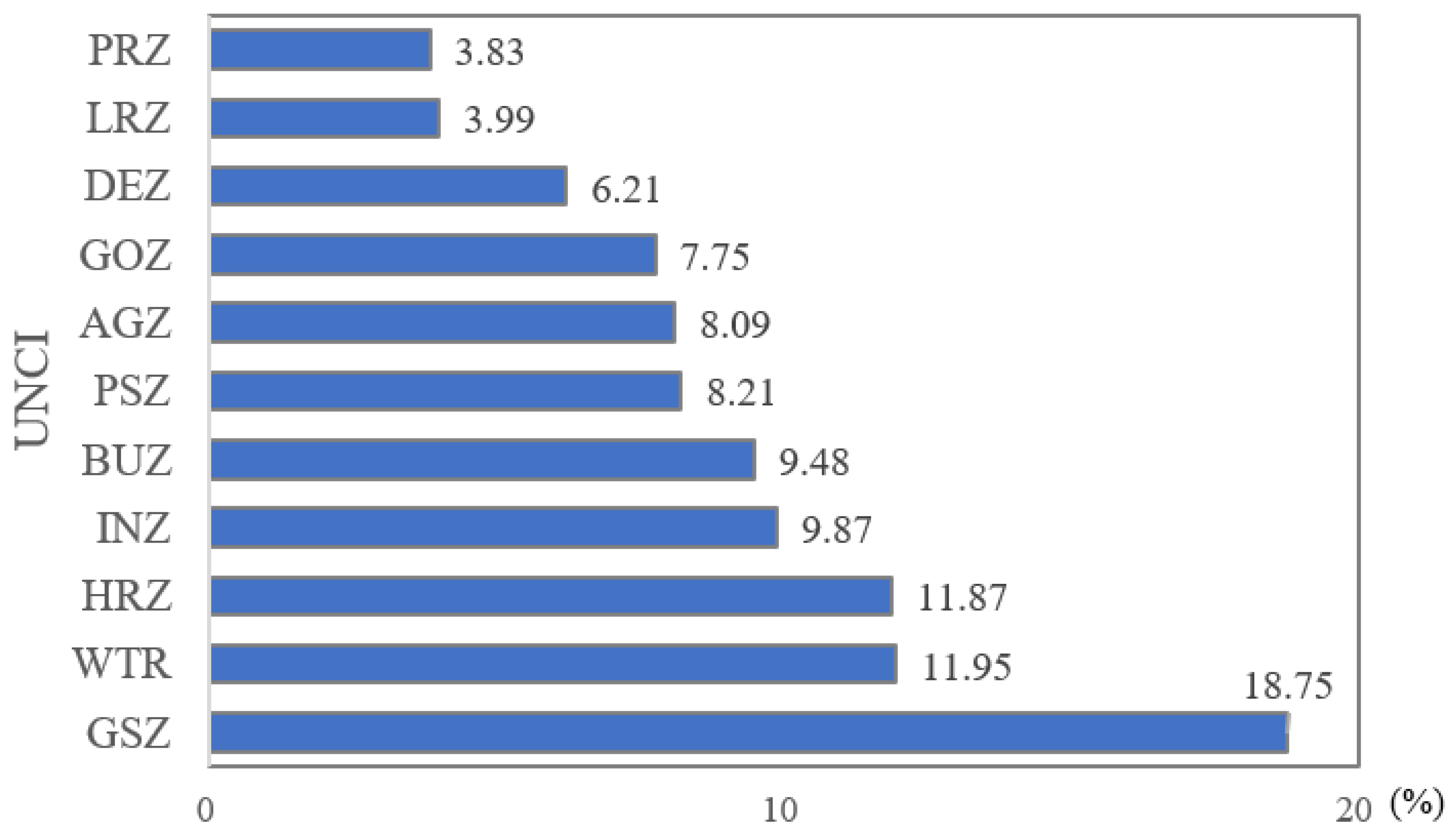
| UFZ | Code | Description |
|---|---|---|
| Low-density residential zone | LRZ | Typical residential communities, with sparse populations and low buildings. |
| High-density residential zone | HRZ | Typical residential communities, including multiple-family houses and apartments with dense populations. |
| Industrial zone | INZ | Factories for manufacturing, repair stations, and storage land. |
| Business zone | BUZ | Offices for finance organizations and markets, restaurants, and hotels. |
| Government zone | GOZ | Governments, public organizations, schools, colleges, and institutes. |
| Public service zone | PSZ | Public service areas, such as stadiums, libraries, museums, and hospitals. |
| Agricultural zone | AGZ | Cultivated land, greenhouses, and other agricultural facilities. |
| Development zone | DEZ | Undeveloped open spaces and construction sites. |
| Green space zone | GSZ | Urban parks and scenic zones with high green coverage. |
| Water | WTR | Open water, including rivers, reservoirs, ponds, and ditches. |
| Preservation zone | PRZ | Open space with natural and artificial green space, such as forest parks. |
| Temperature Zone (TZ) | Temperature Range |
|---|---|
| Low-temperature zone (LTZ) | < − 1.5 S |
| Sub-low-temperature zone (SLTZ) | − 1.5 S ≤ − 0.5 S |
| Medium-temperature zone (MTZ) | − 0.5 S ≤ + 0.5 S |
| Sub-high-temperature zone (SHTZ) | + 0.5 S ≤ + 1.5 S |
| High-temperature zone (HTZ) | ≥ + 1.5 S |
| Patch Grades | Patch Areas (hm2) | Patch Characteristics |
|---|---|---|
| 1 | S ≤ 1 | Tiny patch (TP) |
| 2 | 1 < S ≤ 5 | Small patch (SP) |
| 3 | 5 < S ≤ 10 | Medium patch (MP) |
| 4 | 10 < S ≤ 20 | Large patch (LP) |
| 5 | S > 20 | Super large patch (SLP) |
| Patch Characteristics | a/°C | b/°C | r | Li/km |
|---|---|---|---|---|
| TP | 47.47 ± 0.34 | −0.33 ± 0.04 | 0.03 ± 0.01 | 0.66 |
| SP | 47.15 ± 0.38 | −0.75 ± 0.06 | 0.11 ± 0.01 | 1.09 |
| MP | 46.62 ± 0.35 | −1.04 ± 0.05 | 0.15 ± 0.01 | 1.21 |
| LP | 46.76 ± 0.31 | −2.14 ± 0.07 | 0.32 ± 0.01 | 2.08 |
| SLP | 46.77 ± 0.29 | −3.45 ± 0.07 | 0.36 ± 0.01 | 2.25 |
| Proportions (%) | LTZ | SLTZ | MTZ | SHTZ | HTZ |
|---|---|---|---|---|---|
| AGZ | - | 39.58 | 41.13 | 17.77 | 1.52 |
| BUZ | - | - | 3.09 | 39.62 | 57.29 |
| DEZ | - | 2.03 | 17.45 | 66.03 | 14.49 |
| GOZ | - | - | 8.23 | 58.01 | 33.76 |
| GSZ | - | 9.06 | 50.48 | 37.79 | 2.66 |
| HRZ | - | - | 12.67 | 60.28 | 27.05 |
| LRZ | - | 0.15 | 17.15 | 59.30 | 23.41 |
| INZ | 0.69 | 1.78 | 6.62 | 37.72 | 53.18 |
| PRZ | - | - | 54.77 | 43.85 | 1.37 |
| PSZ | - | - | 7.32 | 37.62 | 55.06 |
| WTR | 1.48 | 52.56 | 32.89 | 11.28 | 1.79 |
Disclaimer/Publisher’s Note: The statements, opinions and data contained in all publications are solely those of the individual author(s) and contributor(s) and not of MDPI and/or the editor(s). MDPI and/or the editor(s) disclaim responsibility for any injury to people or property resulting from any ideas, methods, instructions or products referred to in the content. |
© 2024 by the authors. Licensee MDPI, Basel, Switzerland. This article is an open access article distributed under the terms and conditions of the Creative Commons Attribution (CC BY) license (https://creativecommons.org/licenses/by/4.0/).
Share and Cite
Qi, L.; Hu, Y.; Bu, R.; Li, B.; Gao, Y.; Li, C. Evaluation of the Thermal Environment Based on the Urban Neighborhood Heat/Cool Island Effect. Land 2024, 13, 933. https://doi.org/10.3390/land13070933
Qi L, Hu Y, Bu R, Li B, Gao Y, Li C. Evaluation of the Thermal Environment Based on the Urban Neighborhood Heat/Cool Island Effect. Land. 2024; 13(7):933. https://doi.org/10.3390/land13070933
Chicago/Turabian StyleQi, Li, Yuanman Hu, Rencang Bu, Binglun Li, Yue Gao, and Chunlin Li. 2024. "Evaluation of the Thermal Environment Based on the Urban Neighborhood Heat/Cool Island Effect" Land 13, no. 7: 933. https://doi.org/10.3390/land13070933






